HC2091 Business Finance Report: Australian Market Analysis
VerifiedAdded on 2022/11/25
|18
|3996
|478
Report
AI Summary
This report provides a thorough examination of the Australian financial market, commencing with an introduction to financial markets and their significance. It delves into the structure of the Australian financial market, encompassing various sectors such as accounting, financial markets and planning, banking, insurance, and specialized financial services. The report identifies key market regulators and explores different market types like equity, bond, and derivative markets. It also analyzes financial institutions in Australia, including authorized deposit-taking institutions, and examines sources of financial services. Furthermore, the report analyzes popular capital budgeting tools, the Australian bond and share markets, and discusses foreign investment in the Australian securities market. It concludes with a recommendation for a potential industry for financial investment, providing a comprehensive overview of the Australian financial landscape and its dynamics.

qwertyuiopasdfghjklzxcvbnmqw
ertyuiopasdfghjklzxcvbnmqwert
yuiopasdfghjklzxcvbnmqwertyui
opasdfghjklzxcvbnmqwertyuiop
asdfghjklzxcvbnmqwertyuiopasd
fghjklzxcvbnmqwertyuiopasdfgh
jklzxcvbnmqwertyuiopasdfghjkl
zxcvbnmqwertyuiopasdfghjklzxc
vbnmqwertyuiopasdfghjklzxcvb
nmqwertyuiopasdfghjklzxcvbnm
qwertyuiopasdfghjklzxcvbnmqw
ertyuiopasdfghjklzxcvbnmqwert
yuiopasdfghjklzxcvbnmqwertyui
opasdfghjklzxcvbnmqwertyuiop
asdfghjklzxcvbnmqwertyuiopasd
fghjklzxcvbnmqwertyuiopasdfgh
jklzxcvbnmrtyuiopasdfghjklzxcv
Business Finance
9/16/2019
(Student Name)
ertyuiopasdfghjklzxcvbnmqwert
yuiopasdfghjklzxcvbnmqwertyui
opasdfghjklzxcvbnmqwertyuiop
asdfghjklzxcvbnmqwertyuiopasd
fghjklzxcvbnmqwertyuiopasdfgh
jklzxcvbnmqwertyuiopasdfghjkl
zxcvbnmqwertyuiopasdfghjklzxc
vbnmqwertyuiopasdfghjklzxcvb
nmqwertyuiopasdfghjklzxcvbnm
qwertyuiopasdfghjklzxcvbnmqw
ertyuiopasdfghjklzxcvbnmqwert
yuiopasdfghjklzxcvbnmqwertyui
opasdfghjklzxcvbnmqwertyuiop
asdfghjklzxcvbnmqwertyuiopasd
fghjklzxcvbnmqwertyuiopasdfgh
jklzxcvbnmrtyuiopasdfghjklzxcv
Business Finance
9/16/2019
(Student Name)
Paraphrase This Document
Need a fresh take? Get an instant paraphrase of this document with our AI Paraphraser
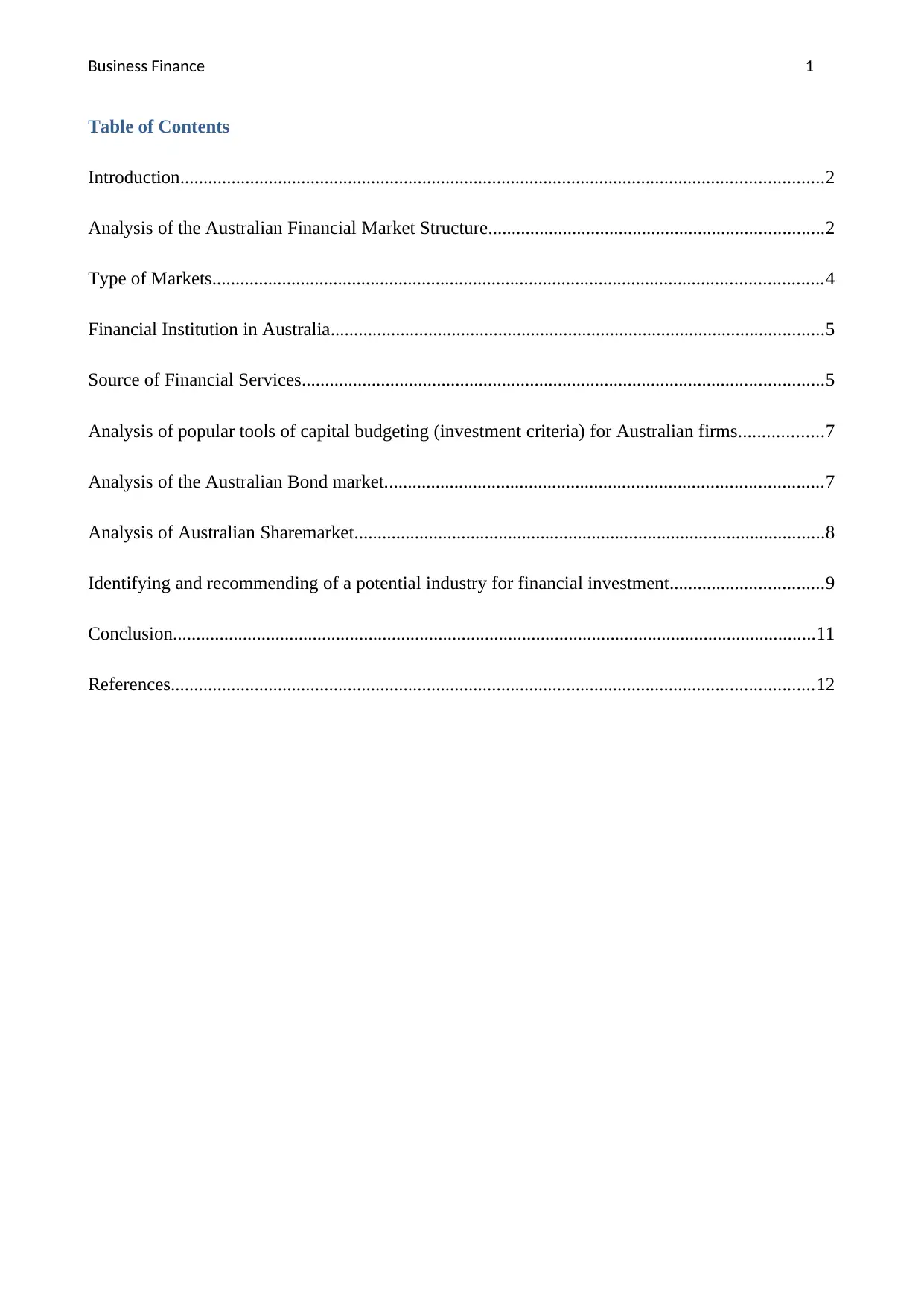
Business Finance 1
Table of Contents
Introduction..........................................................................................................................................2
Analysis of the Australian Financial Market Structure........................................................................2
Type of Markets...................................................................................................................................4
Financial Institution in Australia..........................................................................................................5
Source of Financial Services................................................................................................................5
Analysis of popular tools of capital budgeting (investment criteria) for Australian firms..................7
Analysis of the Australian Bond market..............................................................................................7
Analysis of Australian Sharemarket.....................................................................................................8
Identifying and recommending of a potential industry for financial investment.................................9
Conclusion..........................................................................................................................................11
References..........................................................................................................................................12
Table of Contents
Introduction..........................................................................................................................................2
Analysis of the Australian Financial Market Structure........................................................................2
Type of Markets...................................................................................................................................4
Financial Institution in Australia..........................................................................................................5
Source of Financial Services................................................................................................................5
Analysis of popular tools of capital budgeting (investment criteria) for Australian firms..................7
Analysis of the Australian Bond market..............................................................................................7
Analysis of Australian Sharemarket.....................................................................................................8
Identifying and recommending of a potential industry for financial investment.................................9
Conclusion..........................................................................................................................................11
References..........................................................................................................................................12
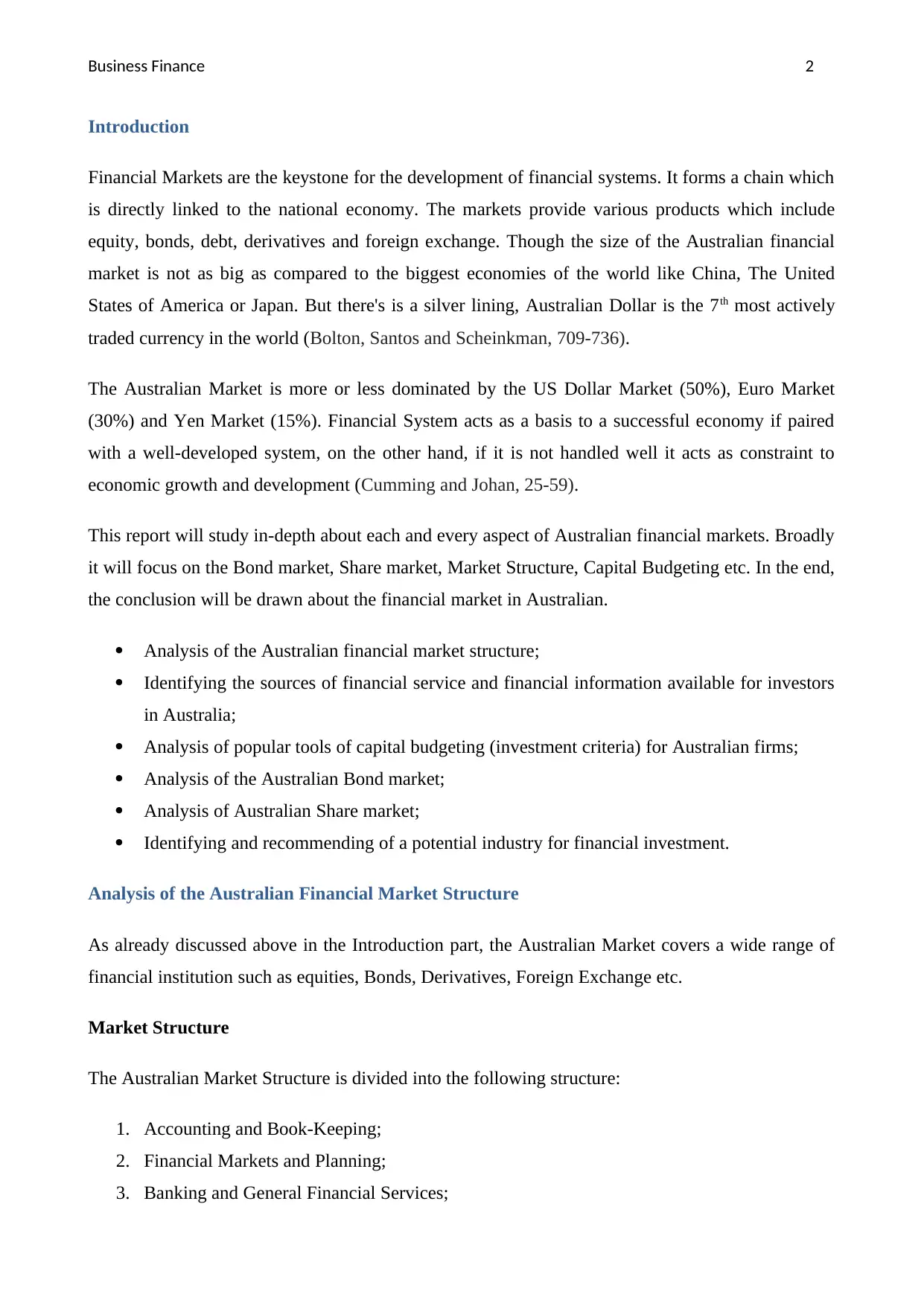
Business Finance 2
Introduction
Financial Markets are the keystone for the development of financial systems. It forms a chain which
is directly linked to the national economy. The markets provide various products which include
equity, bonds, debt, derivatives and foreign exchange. Though the size of the Australian financial
market is not as big as compared to the biggest economies of the world like China, The United
States of America or Japan. But there's is a silver lining, Australian Dollar is the 7th most actively
traded currency in the world (Bolton, Santos and Scheinkman, 709-736).
The Australian Market is more or less dominated by the US Dollar Market (50%), Euro Market
(30%) and Yen Market (15%). Financial System acts as a basis to a successful economy if paired
with a well-developed system, on the other hand, if it is not handled well it acts as constraint to
economic growth and development (Cumming and Johan, 25-59).
This report will study in-depth about each and every aspect of Australian financial markets. Broadly
it will focus on the Bond market, Share market, Market Structure, Capital Budgeting etc. In the end,
the conclusion will be drawn about the financial market in Australian.
Analysis of the Australian financial market structure;
Identifying the sources of financial service and financial information available for investors
in Australia;
Analysis of popular tools of capital budgeting (investment criteria) for Australian firms;
Analysis of the Australian Bond market;
Analysis of Australian Share market;
Identifying and recommending of a potential industry for financial investment.
Analysis of the Australian Financial Market Structure
As already discussed above in the Introduction part, the Australian Market covers a wide range of
financial institution such as equities, Bonds, Derivatives, Foreign Exchange etc.
Market Structure
The Australian Market Structure is divided into the following structure:
1. Accounting and Book-Keeping;
2. Financial Markets and Planning;
3. Banking and General Financial Services;
Introduction
Financial Markets are the keystone for the development of financial systems. It forms a chain which
is directly linked to the national economy. The markets provide various products which include
equity, bonds, debt, derivatives and foreign exchange. Though the size of the Australian financial
market is not as big as compared to the biggest economies of the world like China, The United
States of America or Japan. But there's is a silver lining, Australian Dollar is the 7th most actively
traded currency in the world (Bolton, Santos and Scheinkman, 709-736).
The Australian Market is more or less dominated by the US Dollar Market (50%), Euro Market
(30%) and Yen Market (15%). Financial System acts as a basis to a successful economy if paired
with a well-developed system, on the other hand, if it is not handled well it acts as constraint to
economic growth and development (Cumming and Johan, 25-59).
This report will study in-depth about each and every aspect of Australian financial markets. Broadly
it will focus on the Bond market, Share market, Market Structure, Capital Budgeting etc. In the end,
the conclusion will be drawn about the financial market in Australian.
Analysis of the Australian financial market structure;
Identifying the sources of financial service and financial information available for investors
in Australia;
Analysis of popular tools of capital budgeting (investment criteria) for Australian firms;
Analysis of the Australian Bond market;
Analysis of Australian Share market;
Identifying and recommending of a potential industry for financial investment.
Analysis of the Australian Financial Market Structure
As already discussed above in the Introduction part, the Australian Market covers a wide range of
financial institution such as equities, Bonds, Derivatives, Foreign Exchange etc.
Market Structure
The Australian Market Structure is divided into the following structure:
1. Accounting and Book-Keeping;
2. Financial Markets and Planning;
3. Banking and General Financial Services;
⊘ This is a preview!⊘
Do you want full access?
Subscribe today to unlock all pages.

Trusted by 1+ million students worldwide
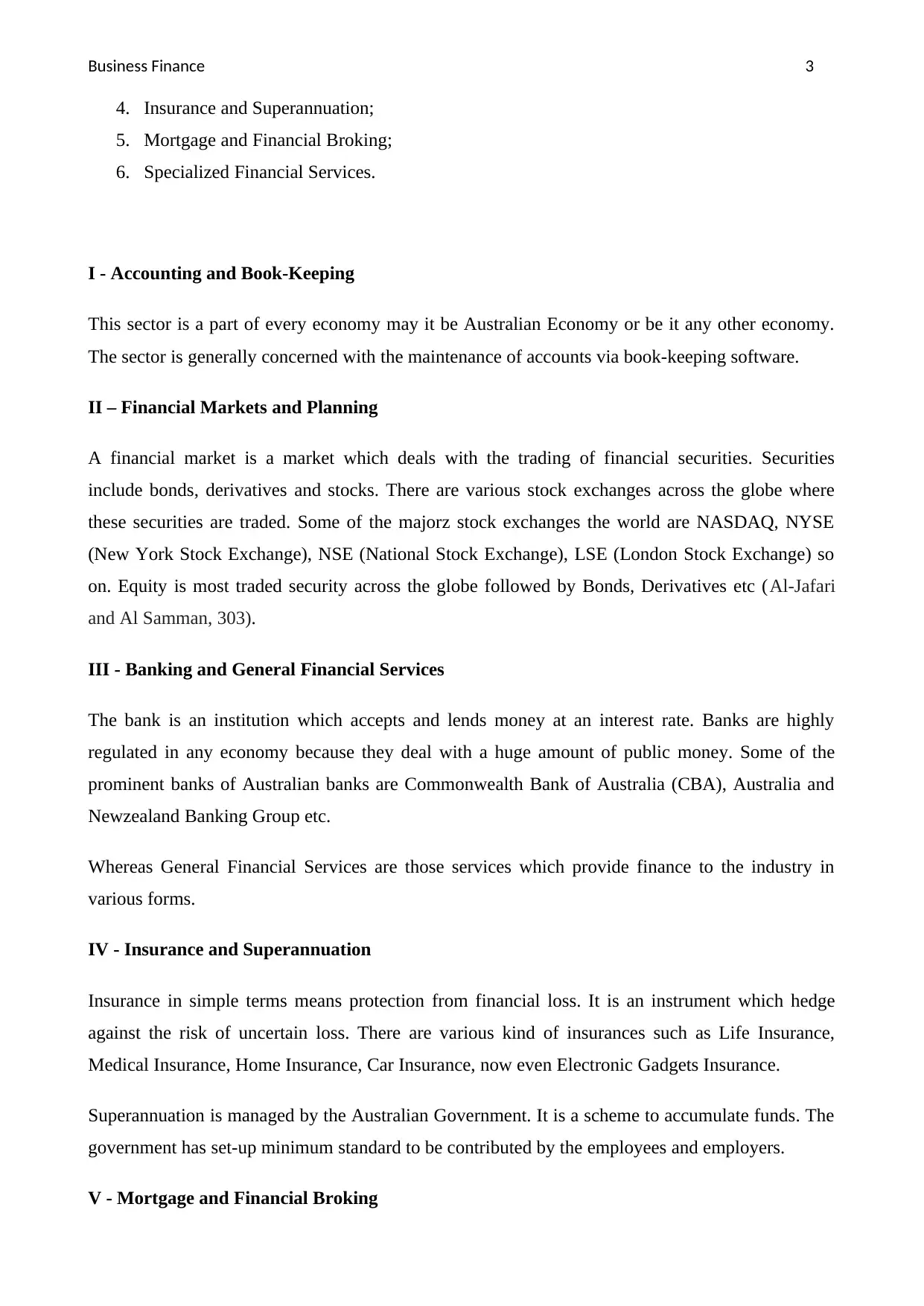
Business Finance 3
4. Insurance and Superannuation;
5. Mortgage and Financial Broking;
6. Specialized Financial Services.
I - Accounting and Book-Keeping
This sector is a part of every economy may it be Australian Economy or be it any other economy.
The sector is generally concerned with the maintenance of accounts via book-keeping software.
II – Financial Markets and Planning
A financial market is a market which deals with the trading of financial securities. Securities
include bonds, derivatives and stocks. There are various stock exchanges across the globe where
these securities are traded. Some of the majorz stock exchanges the world are NASDAQ, NYSE
(New York Stock Exchange), NSE (National Stock Exchange), LSE (London Stock Exchange) so
on. Equity is most traded security across the globe followed by Bonds, Derivatives etc (Al-Jafari
and Al Samman, 303).
III - Banking and General Financial Services
The bank is an institution which accepts and lends money at an interest rate. Banks are highly
regulated in any economy because they deal with a huge amount of public money. Some of the
prominent banks of Australian banks are Commonwealth Bank of Australia (CBA), Australia and
Newzealand Banking Group etc.
Whereas General Financial Services are those services which provide finance to the industry in
various forms.
IV - Insurance and Superannuation
Insurance in simple terms means protection from financial loss. It is an instrument which hedge
against the risk of uncertain loss. There are various kind of insurances such as Life Insurance,
Medical Insurance, Home Insurance, Car Insurance, now even Electronic Gadgets Insurance.
Superannuation is managed by the Australian Government. It is a scheme to accumulate funds. The
government has set-up minimum standard to be contributed by the employees and employers.
V - Mortgage and Financial Broking
4. Insurance and Superannuation;
5. Mortgage and Financial Broking;
6. Specialized Financial Services.
I - Accounting and Book-Keeping
This sector is a part of every economy may it be Australian Economy or be it any other economy.
The sector is generally concerned with the maintenance of accounts via book-keeping software.
II – Financial Markets and Planning
A financial market is a market which deals with the trading of financial securities. Securities
include bonds, derivatives and stocks. There are various stock exchanges across the globe where
these securities are traded. Some of the majorz stock exchanges the world are NASDAQ, NYSE
(New York Stock Exchange), NSE (National Stock Exchange), LSE (London Stock Exchange) so
on. Equity is most traded security across the globe followed by Bonds, Derivatives etc (Al-Jafari
and Al Samman, 303).
III - Banking and General Financial Services
The bank is an institution which accepts and lends money at an interest rate. Banks are highly
regulated in any economy because they deal with a huge amount of public money. Some of the
prominent banks of Australian banks are Commonwealth Bank of Australia (CBA), Australia and
Newzealand Banking Group etc.
Whereas General Financial Services are those services which provide finance to the industry in
various forms.
IV - Insurance and Superannuation
Insurance in simple terms means protection from financial loss. It is an instrument which hedge
against the risk of uncertain loss. There are various kind of insurances such as Life Insurance,
Medical Insurance, Home Insurance, Car Insurance, now even Electronic Gadgets Insurance.
Superannuation is managed by the Australian Government. It is a scheme to accumulate funds. The
government has set-up minimum standard to be contributed by the employees and employers.
V - Mortgage and Financial Broking
Paraphrase This Document
Need a fresh take? Get an instant paraphrase of this document with our AI Paraphraser
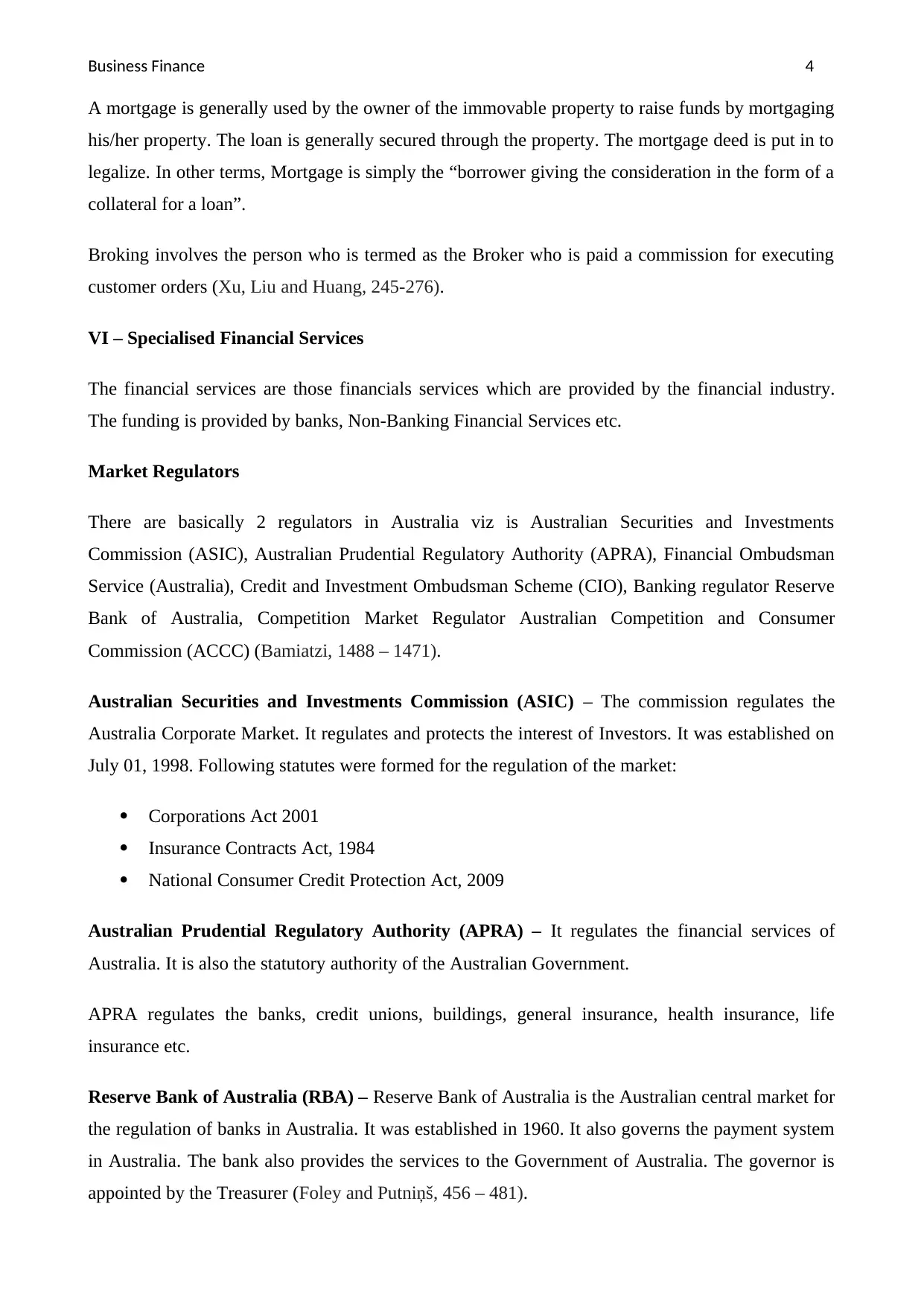
Business Finance 4
A mortgage is generally used by the owner of the immovable property to raise funds by mortgaging
his/her property. The loan is generally secured through the property. The mortgage deed is put in to
legalize. In other terms, Mortgage is simply the “borrower giving the consideration in the form of a
collateral for a loan”.
Broking involves the person who is termed as the Broker who is paid a commission for executing
customer orders (Xu, Liu and Huang, 245-276).
VI – Specialised Financial Services
The financial services are those financials services which are provided by the financial industry.
The funding is provided by banks, Non-Banking Financial Services etc.
Market Regulators
There are basically 2 regulators in Australia viz is Australian Securities and Investments
Commission (ASIC), Australian Prudential Regulatory Authority (APRA), Financial Ombudsman
Service (Australia), Credit and Investment Ombudsman Scheme (CIO), Banking regulator Reserve
Bank of Australia, Competition Market Regulator Australian Competition and Consumer
Commission (ACCC) (Bamiatzi, 1488 – 1471).
Australian Securities and Investments Commission (ASIC) – The commission regulates the
Australia Corporate Market. It regulates and protects the interest of Investors. It was established on
July 01, 1998. Following statutes were formed for the regulation of the market:
Corporations Act 2001
Insurance Contracts Act, 1984
National Consumer Credit Protection Act, 2009
Australian Prudential Regulatory Authority (APRA) – It regulates the financial services of
Australia. It is also the statutory authority of the Australian Government.
APRA regulates the banks, credit unions, buildings, general insurance, health insurance, life
insurance etc.
Reserve Bank of Australia (RBA) – Reserve Bank of Australia is the Australian central market for
the regulation of banks in Australia. It was established in 1960. It also governs the payment system
in Australia. The bank also provides the services to the Government of Australia. The governor is
appointed by the Treasurer (Foley and Putniņš, 456 – 481).
A mortgage is generally used by the owner of the immovable property to raise funds by mortgaging
his/her property. The loan is generally secured through the property. The mortgage deed is put in to
legalize. In other terms, Mortgage is simply the “borrower giving the consideration in the form of a
collateral for a loan”.
Broking involves the person who is termed as the Broker who is paid a commission for executing
customer orders (Xu, Liu and Huang, 245-276).
VI – Specialised Financial Services
The financial services are those financials services which are provided by the financial industry.
The funding is provided by banks, Non-Banking Financial Services etc.
Market Regulators
There are basically 2 regulators in Australia viz is Australian Securities and Investments
Commission (ASIC), Australian Prudential Regulatory Authority (APRA), Financial Ombudsman
Service (Australia), Credit and Investment Ombudsman Scheme (CIO), Banking regulator Reserve
Bank of Australia, Competition Market Regulator Australian Competition and Consumer
Commission (ACCC) (Bamiatzi, 1488 – 1471).
Australian Securities and Investments Commission (ASIC) – The commission regulates the
Australia Corporate Market. It regulates and protects the interest of Investors. It was established on
July 01, 1998. Following statutes were formed for the regulation of the market:
Corporations Act 2001
Insurance Contracts Act, 1984
National Consumer Credit Protection Act, 2009
Australian Prudential Regulatory Authority (APRA) – It regulates the financial services of
Australia. It is also the statutory authority of the Australian Government.
APRA regulates the banks, credit unions, buildings, general insurance, health insurance, life
insurance etc.
Reserve Bank of Australia (RBA) – Reserve Bank of Australia is the Australian central market for
the regulation of banks in Australia. It was established in 1960. It also governs the payment system
in Australia. The bank also provides the services to the Government of Australia. The governor is
appointed by the Treasurer (Foley and Putniņš, 456 – 481).
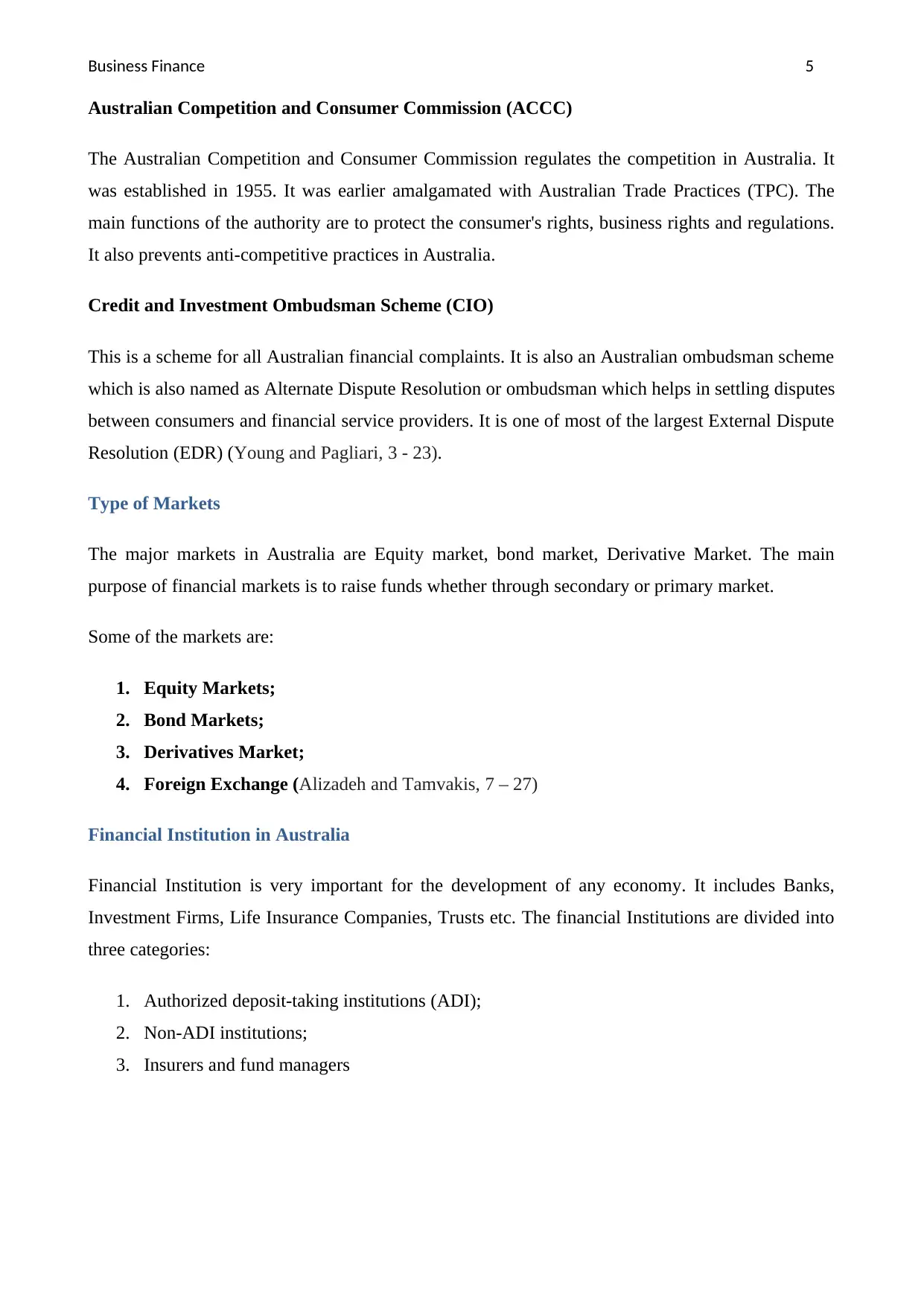
Business Finance 5
Australian Competition and Consumer Commission (ACCC)
The Australian Competition and Consumer Commission regulates the competition in Australia. It
was established in 1955. It was earlier amalgamated with Australian Trade Practices (TPC). The
main functions of the authority are to protect the consumer's rights, business rights and regulations.
It also prevents anti-competitive practices in Australia.
Credit and Investment Ombudsman Scheme (CIO)
This is a scheme for all Australian financial complaints. It is also an Australian ombudsman scheme
which is also named as Alternate Dispute Resolution or ombudsman which helps in settling disputes
between consumers and financial service providers. It is one of most of the largest External Dispute
Resolution (EDR) (Young and Pagliari, 3 - 23).
Type of Markets
The major markets in Australia are Equity market, bond market, Derivative Market. The main
purpose of financial markets is to raise funds whether through secondary or primary market.
Some of the markets are:
1. Equity Markets;
2. Bond Markets;
3. Derivatives Market;
4. Foreign Exchange (Alizadeh and Tamvakis, 7 – 27)
Financial Institution in Australia
Financial Institution is very important for the development of any economy. It includes Banks,
Investment Firms, Life Insurance Companies, Trusts etc. The financial Institutions are divided into
three categories:
1. Authorized deposit-taking institutions (ADI);
2. Non-ADI institutions;
3. Insurers and fund managers
Australian Competition and Consumer Commission (ACCC)
The Australian Competition and Consumer Commission regulates the competition in Australia. It
was established in 1955. It was earlier amalgamated with Australian Trade Practices (TPC). The
main functions of the authority are to protect the consumer's rights, business rights and regulations.
It also prevents anti-competitive practices in Australia.
Credit and Investment Ombudsman Scheme (CIO)
This is a scheme for all Australian financial complaints. It is also an Australian ombudsman scheme
which is also named as Alternate Dispute Resolution or ombudsman which helps in settling disputes
between consumers and financial service providers. It is one of most of the largest External Dispute
Resolution (EDR) (Young and Pagliari, 3 - 23).
Type of Markets
The major markets in Australia are Equity market, bond market, Derivative Market. The main
purpose of financial markets is to raise funds whether through secondary or primary market.
Some of the markets are:
1. Equity Markets;
2. Bond Markets;
3. Derivatives Market;
4. Foreign Exchange (Alizadeh and Tamvakis, 7 – 27)
Financial Institution in Australia
Financial Institution is very important for the development of any economy. It includes Banks,
Investment Firms, Life Insurance Companies, Trusts etc. The financial Institutions are divided into
three categories:
1. Authorized deposit-taking institutions (ADI);
2. Non-ADI institutions;
3. Insurers and fund managers
⊘ This is a preview!⊘
Do you want full access?
Subscribe today to unlock all pages.

Trusted by 1+ million students worldwide
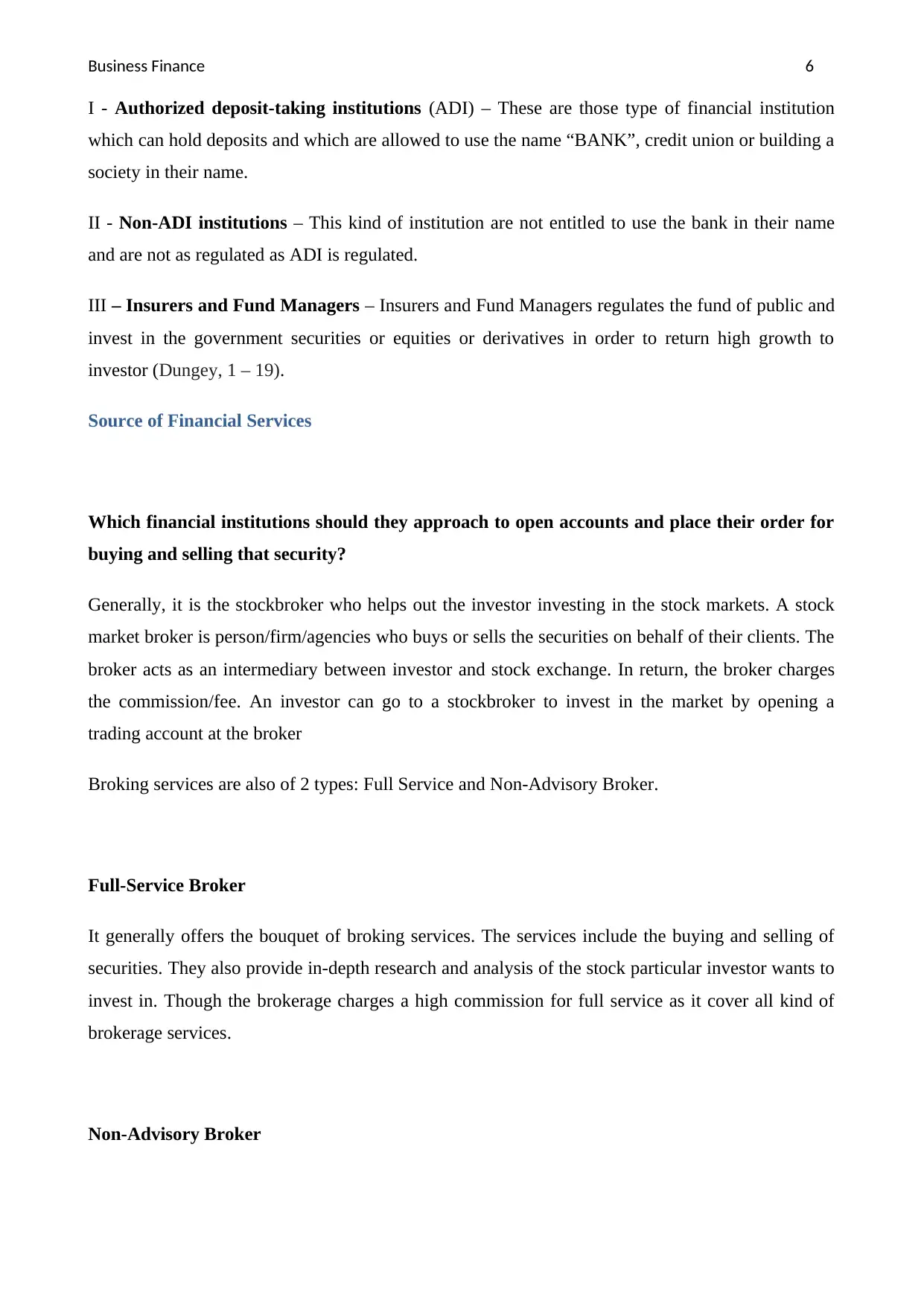
Business Finance 6
I - Authorized deposit-taking institutions (ADI) – These are those type of financial institution
which can hold deposits and which are allowed to use the name “BANK”, credit union or building a
society in their name.
II - Non-ADI institutions – This kind of institution are not entitled to use the bank in their name
and are not as regulated as ADI is regulated.
III – Insurers and Fund Managers – Insurers and Fund Managers regulates the fund of public and
invest in the government securities or equities or derivatives in order to return high growth to
investor (Dungey, 1 – 19).
Source of Financial Services
Which financial institutions should they approach to open accounts and place their order for
buying and selling that security?
Generally, it is the stockbroker who helps out the investor investing in the stock markets. A stock
market broker is person/firm/agencies who buys or sells the securities on behalf of their clients. The
broker acts as an intermediary between investor and stock exchange. In return, the broker charges
the commission/fee. An investor can go to a stockbroker to invest in the market by opening a
trading account at the broker
Broking services are also of 2 types: Full Service and Non-Advisory Broker.
Full-Service Broker
It generally offers the bouquet of broking services. The services include the buying and selling of
securities. They also provide in-depth research and analysis of the stock particular investor wants to
invest in. Though the brokerage charges a high commission for full service as it cover all kind of
brokerage services.
Non-Advisory Broker
I - Authorized deposit-taking institutions (ADI) – These are those type of financial institution
which can hold deposits and which are allowed to use the name “BANK”, credit union or building a
society in their name.
II - Non-ADI institutions – This kind of institution are not entitled to use the bank in their name
and are not as regulated as ADI is regulated.
III – Insurers and Fund Managers – Insurers and Fund Managers regulates the fund of public and
invest in the government securities or equities or derivatives in order to return high growth to
investor (Dungey, 1 – 19).
Source of Financial Services
Which financial institutions should they approach to open accounts and place their order for
buying and selling that security?
Generally, it is the stockbroker who helps out the investor investing in the stock markets. A stock
market broker is person/firm/agencies who buys or sells the securities on behalf of their clients. The
broker acts as an intermediary between investor and stock exchange. In return, the broker charges
the commission/fee. An investor can go to a stockbroker to invest in the market by opening a
trading account at the broker
Broking services are also of 2 types: Full Service and Non-Advisory Broker.
Full-Service Broker
It generally offers the bouquet of broking services. The services include the buying and selling of
securities. They also provide in-depth research and analysis of the stock particular investor wants to
invest in. Though the brokerage charges a high commission for full service as it cover all kind of
brokerage services.
Non-Advisory Broker
Paraphrase This Document
Need a fresh take? Get an instant paraphrase of this document with our AI Paraphraser
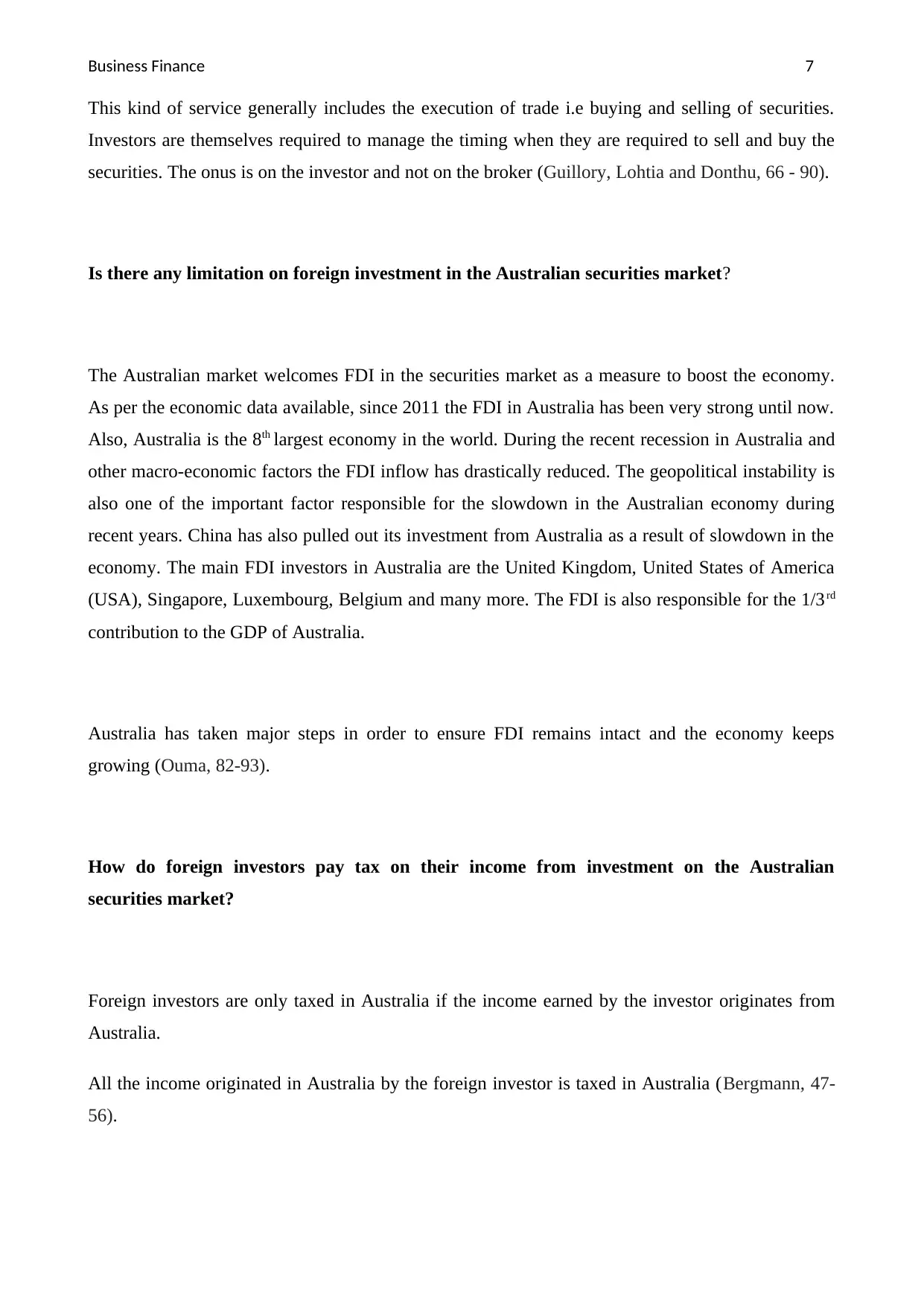
Business Finance 7
This kind of service generally includes the execution of trade i.e buying and selling of securities.
Investors are themselves required to manage the timing when they are required to sell and buy the
securities. The onus is on the investor and not on the broker (Guillory, Lohtia and Donthu, 66 - 90).
Is there any limitation on foreign investment in the Australian securities market?
The Australian market welcomes FDI in the securities market as a measure to boost the economy.
As per the economic data available, since 2011 the FDI in Australia has been very strong until now.
Also, Australia is the 8th largest economy in the world. During the recent recession in Australia and
other macro-economic factors the FDI inflow has drastically reduced. The geopolitical instability is
also one of the important factor responsible for the slowdown in the Australian economy during
recent years. China has also pulled out its investment from Australia as a result of slowdown in the
economy. The main FDI investors in Australia are the United Kingdom, United States of America
(USA), Singapore, Luxembourg, Belgium and many more. The FDI is also responsible for the 1/3rd
contribution to the GDP of Australia.
Australia has taken major steps in order to ensure FDI remains intact and the economy keeps
growing (Ouma, 82-93).
How do foreign investors pay tax on their income from investment on the Australian
securities market?
Foreign investors are only taxed in Australia if the income earned by the investor originates from
Australia.
All the income originated in Australia by the foreign investor is taxed in Australia (Bergmann, 47-
56).
This kind of service generally includes the execution of trade i.e buying and selling of securities.
Investors are themselves required to manage the timing when they are required to sell and buy the
securities. The onus is on the investor and not on the broker (Guillory, Lohtia and Donthu, 66 - 90).
Is there any limitation on foreign investment in the Australian securities market?
The Australian market welcomes FDI in the securities market as a measure to boost the economy.
As per the economic data available, since 2011 the FDI in Australia has been very strong until now.
Also, Australia is the 8th largest economy in the world. During the recent recession in Australia and
other macro-economic factors the FDI inflow has drastically reduced. The geopolitical instability is
also one of the important factor responsible for the slowdown in the Australian economy during
recent years. China has also pulled out its investment from Australia as a result of slowdown in the
economy. The main FDI investors in Australia are the United Kingdom, United States of America
(USA), Singapore, Luxembourg, Belgium and many more. The FDI is also responsible for the 1/3rd
contribution to the GDP of Australia.
Australia has taken major steps in order to ensure FDI remains intact and the economy keeps
growing (Ouma, 82-93).
How do foreign investors pay tax on their income from investment on the Australian
securities market?
Foreign investors are only taxed in Australia if the income earned by the investor originates from
Australia.
All the income originated in Australia by the foreign investor is taxed in Australia (Bergmann, 47-
56).
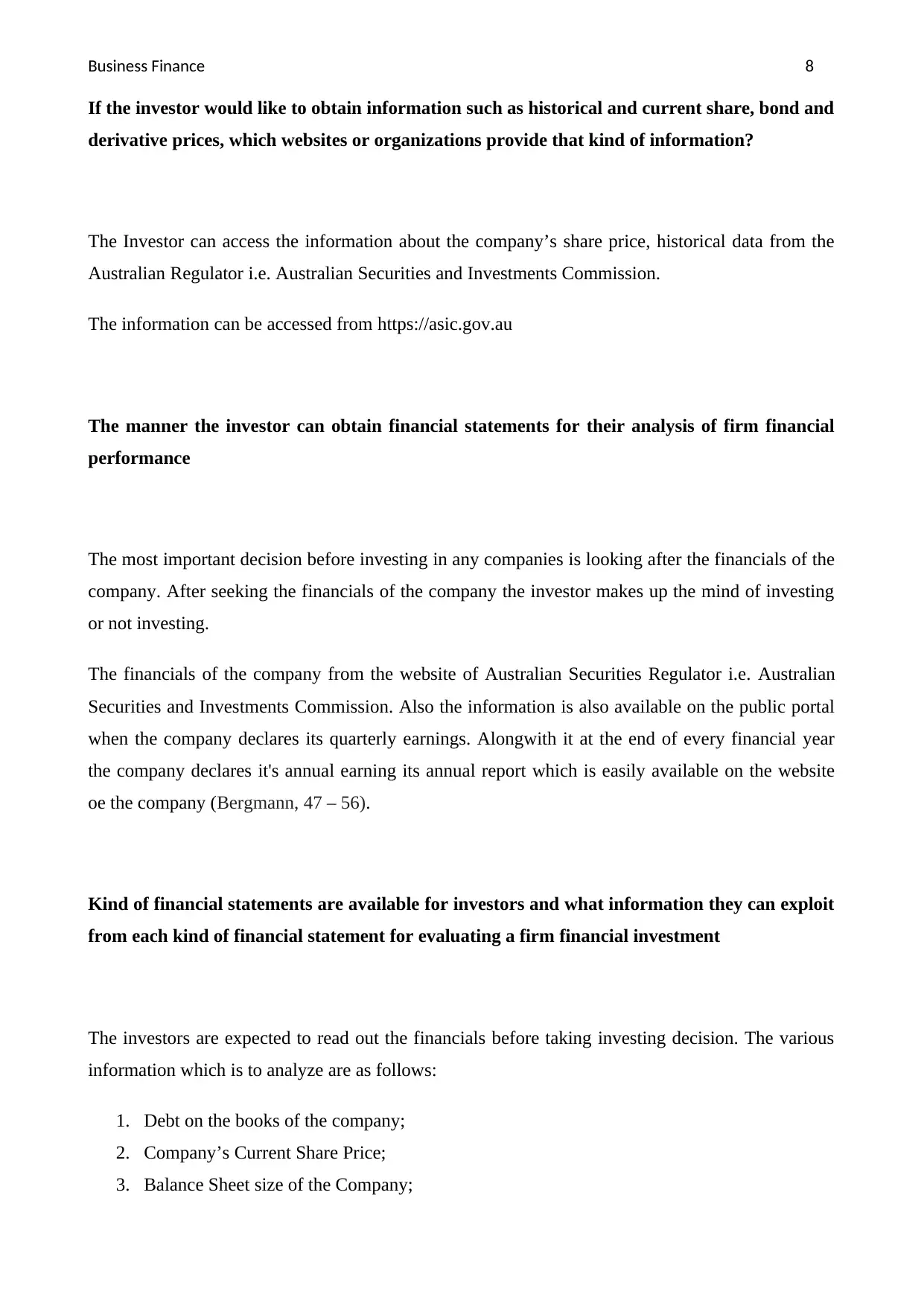
Business Finance 8
If the investor would like to obtain information such as historical and current share, bond and
derivative prices, which websites or organizations provide that kind of information?
The Investor can access the information about the company’s share price, historical data from the
Australian Regulator i.e. Australian Securities and Investments Commission.
The information can be accessed from https://asic.gov.au
The manner the investor can obtain financial statements for their analysis of firm financial
performance
The most important decision before investing in any companies is looking after the financials of the
company. After seeking the financials of the company the investor makes up the mind of investing
or not investing.
The financials of the company from the website of Australian Securities Regulator i.e. Australian
Securities and Investments Commission. Also the information is also available on the public portal
when the company declares its quarterly earnings. Alongwith it at the end of every financial year
the company declares it's annual earning its annual report which is easily available on the website
oe the company (Bergmann, 47 – 56).
Kind of financial statements are available for investors and what information they can exploit
from each kind of financial statement for evaluating a firm financial investment
The investors are expected to read out the financials before taking investing decision. The various
information which is to analyze are as follows:
1. Debt on the books of the company;
2. Company’s Current Share Price;
3. Balance Sheet size of the Company;
If the investor would like to obtain information such as historical and current share, bond and
derivative prices, which websites or organizations provide that kind of information?
The Investor can access the information about the company’s share price, historical data from the
Australian Regulator i.e. Australian Securities and Investments Commission.
The information can be accessed from https://asic.gov.au
The manner the investor can obtain financial statements for their analysis of firm financial
performance
The most important decision before investing in any companies is looking after the financials of the
company. After seeking the financials of the company the investor makes up the mind of investing
or not investing.
The financials of the company from the website of Australian Securities Regulator i.e. Australian
Securities and Investments Commission. Also the information is also available on the public portal
when the company declares its quarterly earnings. Alongwith it at the end of every financial year
the company declares it's annual earning its annual report which is easily available on the website
oe the company (Bergmann, 47 – 56).
Kind of financial statements are available for investors and what information they can exploit
from each kind of financial statement for evaluating a firm financial investment
The investors are expected to read out the financials before taking investing decision. The various
information which is to analyze are as follows:
1. Debt on the books of the company;
2. Company’s Current Share Price;
3. Balance Sheet size of the Company;
⊘ This is a preview!⊘
Do you want full access?
Subscribe today to unlock all pages.

Trusted by 1+ million students worldwide
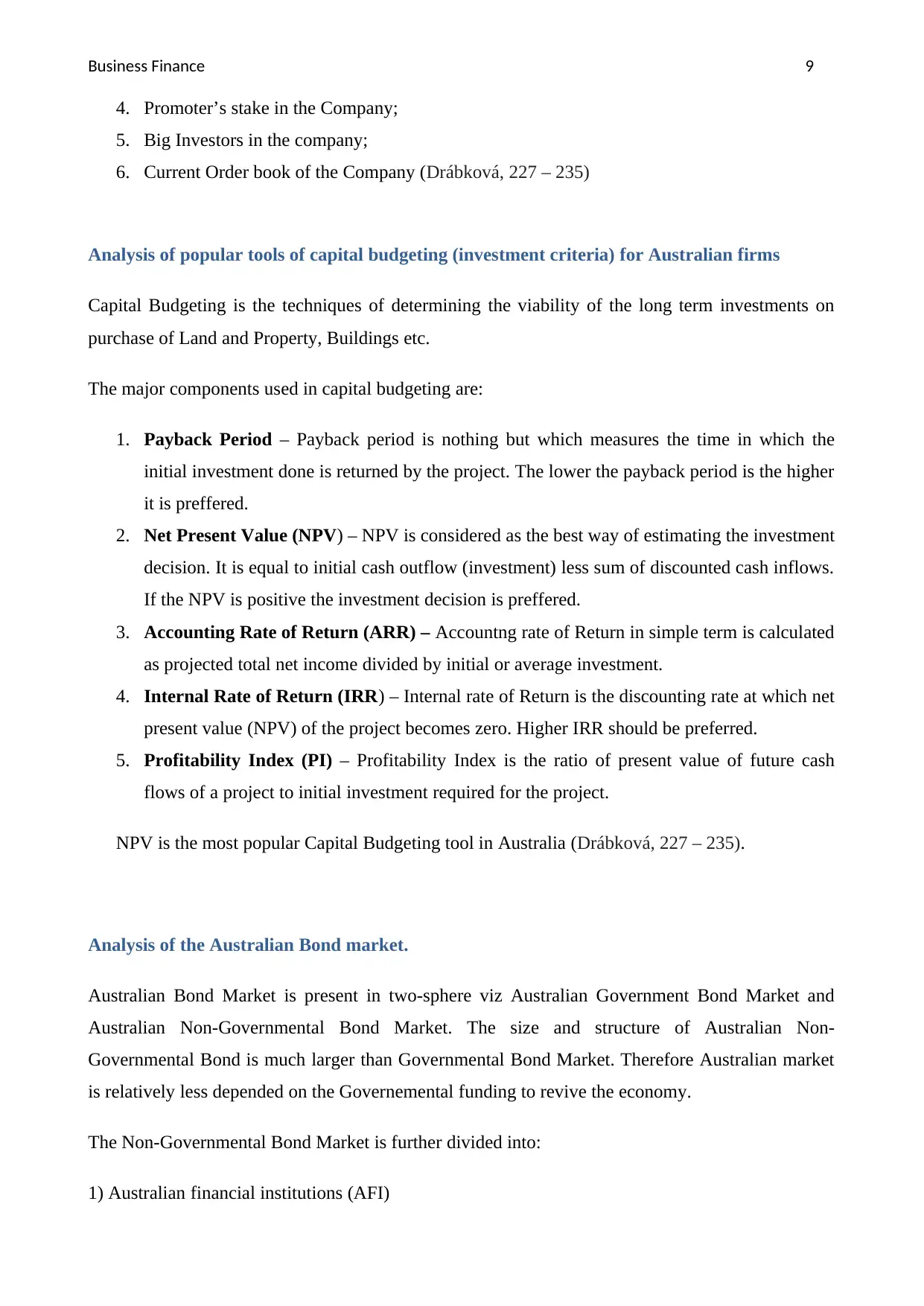
Business Finance 9
4. Promoter’s stake in the Company;
5. Big Investors in the company;
6. Current Order book of the Company (Drábková, 227 – 235)
Analysis of popular tools of capital budgeting (investment criteria) for Australian firms
Capital Budgeting is the techniques of determining the viability of the long term investments on
purchase of Land and Property, Buildings etc.
The major components used in capital budgeting are:
1. Payback Period – Payback period is nothing but which measures the time in which the
initial investment done is returned by the project. The lower the payback period is the higher
it is preffered.
2. Net Present Value (NPV) – NPV is considered as the best way of estimating the investment
decision. It is equal to initial cash outflow (investment) less sum of discounted cash inflows.
If the NPV is positive the investment decision is preffered.
3. Accounting Rate of Return (ARR) – Accountng rate of Return in simple term is calculated
as projected total net income divided by initial or average investment.
4. Internal Rate of Return (IRR) – Internal rate of Return is the discounting rate at which net
present value (NPV) of the project becomes zero. Higher IRR should be preferred.
5. Profitability Index (PI) – Profitability Index is the ratio of present value of future cash
flows of a project to initial investment required for the project.
NPV is the most popular Capital Budgeting tool in Australia (Drábková, 227 – 235).
Analysis of the Australian Bond market.
Australian Bond Market is present in two-sphere viz Australian Government Bond Market and
Australian Non-Governmental Bond Market. The size and structure of Australian Non-
Governmental Bond is much larger than Governmental Bond Market. Therefore Australian market
is relatively less depended on the Governemental funding to revive the economy.
The Non-Governmental Bond Market is further divided into:
1) Australian financial institutions (AFI)
4. Promoter’s stake in the Company;
5. Big Investors in the company;
6. Current Order book of the Company (Drábková, 227 – 235)
Analysis of popular tools of capital budgeting (investment criteria) for Australian firms
Capital Budgeting is the techniques of determining the viability of the long term investments on
purchase of Land and Property, Buildings etc.
The major components used in capital budgeting are:
1. Payback Period – Payback period is nothing but which measures the time in which the
initial investment done is returned by the project. The lower the payback period is the higher
it is preffered.
2. Net Present Value (NPV) – NPV is considered as the best way of estimating the investment
decision. It is equal to initial cash outflow (investment) less sum of discounted cash inflows.
If the NPV is positive the investment decision is preffered.
3. Accounting Rate of Return (ARR) – Accountng rate of Return in simple term is calculated
as projected total net income divided by initial or average investment.
4. Internal Rate of Return (IRR) – Internal rate of Return is the discounting rate at which net
present value (NPV) of the project becomes zero. Higher IRR should be preferred.
5. Profitability Index (PI) – Profitability Index is the ratio of present value of future cash
flows of a project to initial investment required for the project.
NPV is the most popular Capital Budgeting tool in Australia (Drábková, 227 – 235).
Analysis of the Australian Bond market.
Australian Bond Market is present in two-sphere viz Australian Government Bond Market and
Australian Non-Governmental Bond Market. The size and structure of Australian Non-
Governmental Bond is much larger than Governmental Bond Market. Therefore Australian market
is relatively less depended on the Governemental funding to revive the economy.
The Non-Governmental Bond Market is further divided into:
1) Australian financial institutions (AFI)
Paraphrase This Document
Need a fresh take? Get an instant paraphrase of this document with our AI Paraphraser
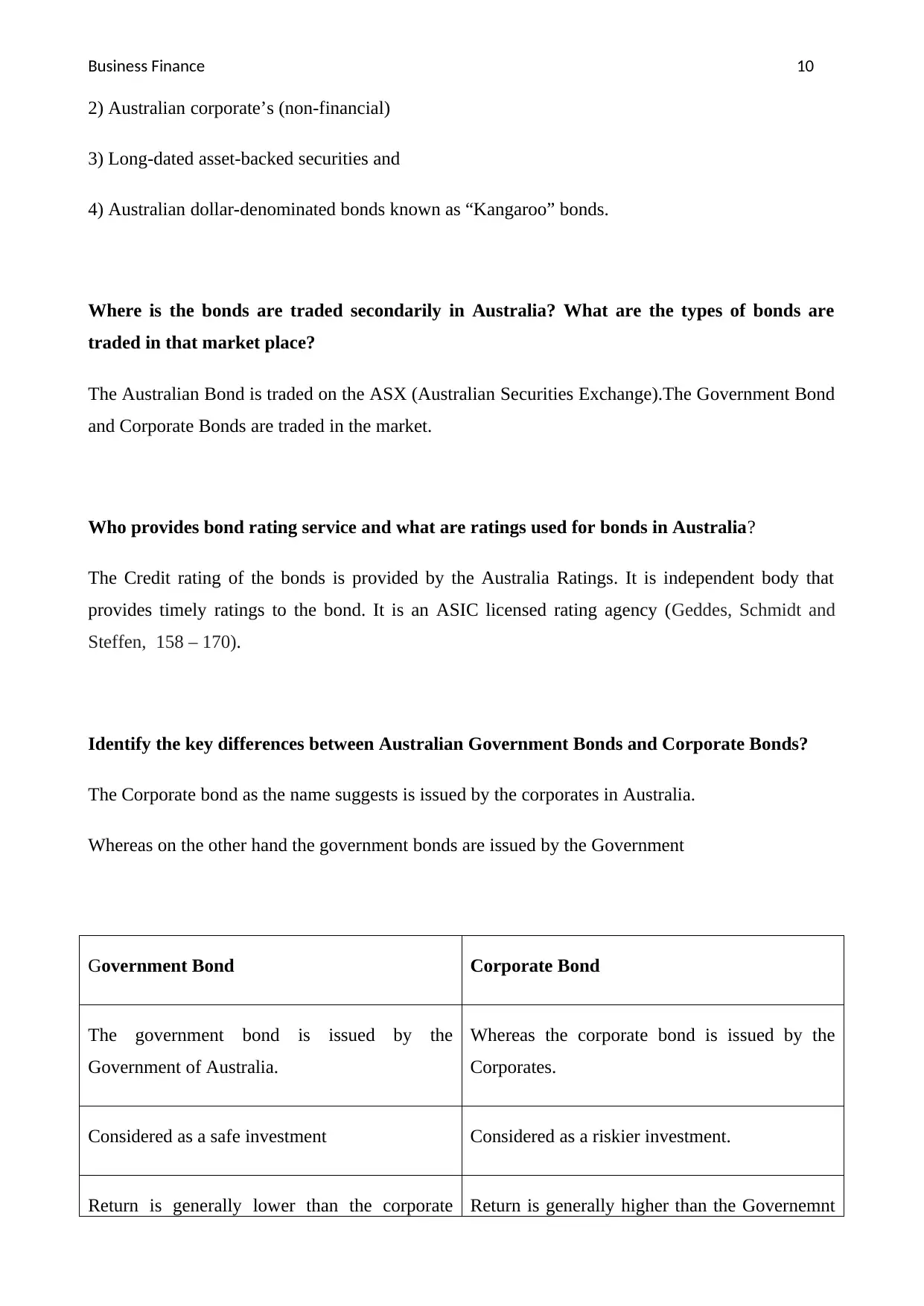
Business Finance 10
2) Australian corporate’s (non-financial)
3) Long-dated asset-backed securities and
4) Australian dollar-denominated bonds known as “Kangaroo” bonds.
Where is the bonds are traded secondarily in Australia? What are the types of bonds are
traded in that market place?
The Australian Bond is traded on the ASX (Australian Securities Exchange).The Government Bond
and Corporate Bonds are traded in the market.
Who provides bond rating service and what are ratings used for bonds in Australia?
The Credit rating of the bonds is provided by the Australia Ratings. It is independent body that
provides timely ratings to the bond. It is an ASIC licensed rating agency (Geddes, Schmidt and
Steffen, 158 – 170).
Identify the key differences between Australian Government Bonds and Corporate Bonds?
The Corporate bond as the name suggests is issued by the corporates in Australia.
Whereas on the other hand the government bonds are issued by the Government
Government Bond Corporate Bond
The government bond is issued by the
Government of Australia.
Whereas the corporate bond is issued by the
Corporates.
Considered as a safe investment Considered as a riskier investment.
Return is generally lower than the corporate Return is generally higher than the Governemnt
2) Australian corporate’s (non-financial)
3) Long-dated asset-backed securities and
4) Australian dollar-denominated bonds known as “Kangaroo” bonds.
Where is the bonds are traded secondarily in Australia? What are the types of bonds are
traded in that market place?
The Australian Bond is traded on the ASX (Australian Securities Exchange).The Government Bond
and Corporate Bonds are traded in the market.
Who provides bond rating service and what are ratings used for bonds in Australia?
The Credit rating of the bonds is provided by the Australia Ratings. It is independent body that
provides timely ratings to the bond. It is an ASIC licensed rating agency (Geddes, Schmidt and
Steffen, 158 – 170).
Identify the key differences between Australian Government Bonds and Corporate Bonds?
The Corporate bond as the name suggests is issued by the corporates in Australia.
Whereas on the other hand the government bonds are issued by the Government
Government Bond Corporate Bond
The government bond is issued by the
Government of Australia.
Whereas the corporate bond is issued by the
Corporates.
Considered as a safe investment Considered as a riskier investment.
Return is generally lower than the corporate Return is generally higher than the Governemnt
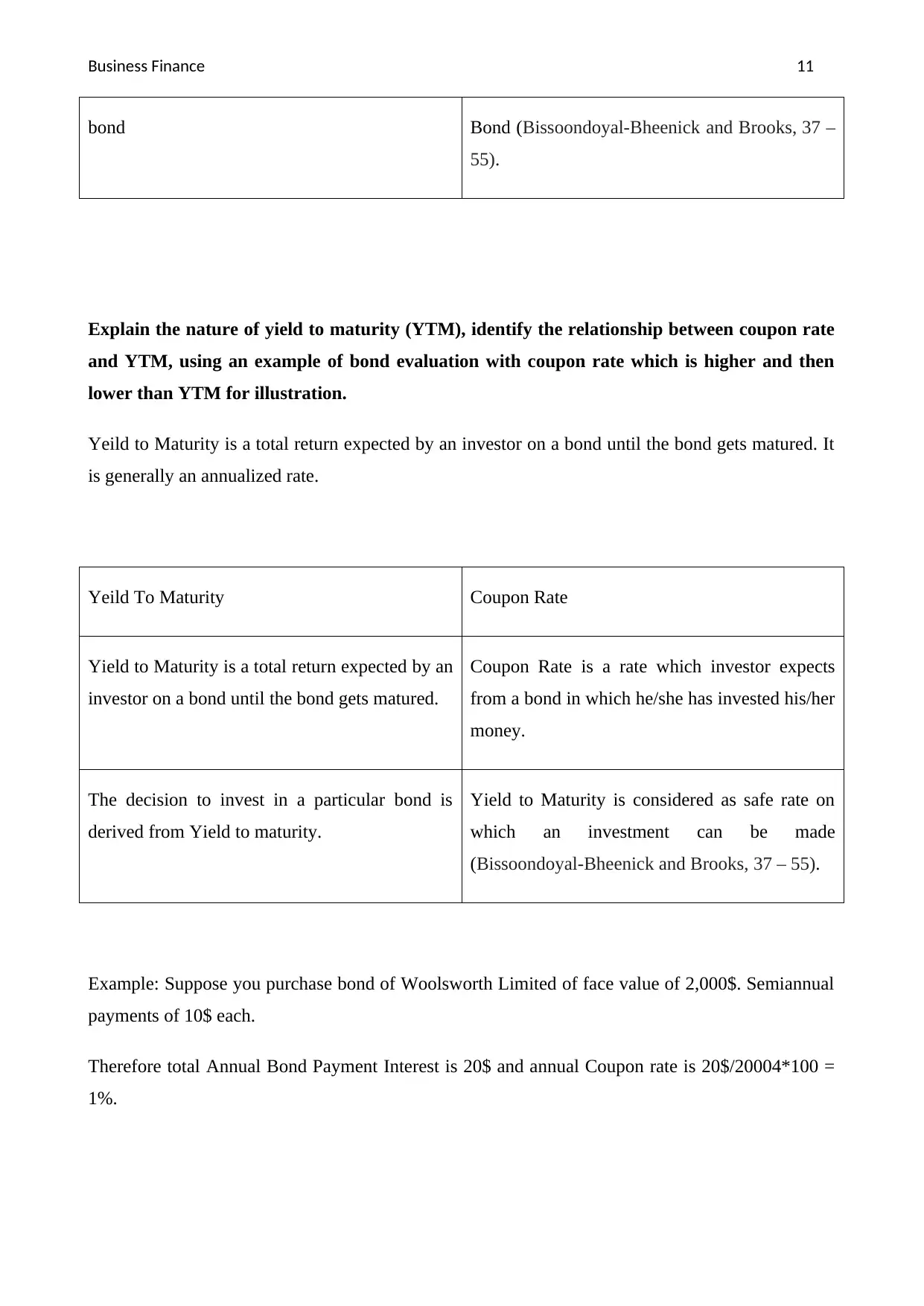
Business Finance 11
bond Bond (Bissoondoyal-Bheenick and Brooks, 37 –
55).
Explain the nature of yield to maturity (YTM), identify the relationship between coupon rate
and YTM, using an example of bond evaluation with coupon rate which is higher and then
lower than YTM for illustration.
Yeild to Maturity is a total return expected by an investor on a bond until the bond gets matured. It
is generally an annualized rate.
Yeild To Maturity Coupon Rate
Yield to Maturity is a total return expected by an
investor on a bond until the bond gets matured.
Coupon Rate is a rate which investor expects
from a bond in which he/she has invested his/her
money.
The decision to invest in a particular bond is
derived from Yield to maturity.
Yield to Maturity is considered as safe rate on
which an investment can be made
(Bissoondoyal-Bheenick and Brooks, 37 – 55).
Example: Suppose you purchase bond of Woolsworth Limited of face value of 2,000$. Semiannual
payments of 10$ each.
Therefore total Annual Bond Payment Interest is 20$ and annual Coupon rate is 20$/20004*100 =
1%.
bond Bond (Bissoondoyal-Bheenick and Brooks, 37 –
55).
Explain the nature of yield to maturity (YTM), identify the relationship between coupon rate
and YTM, using an example of bond evaluation with coupon rate which is higher and then
lower than YTM for illustration.
Yeild to Maturity is a total return expected by an investor on a bond until the bond gets matured. It
is generally an annualized rate.
Yeild To Maturity Coupon Rate
Yield to Maturity is a total return expected by an
investor on a bond until the bond gets matured.
Coupon Rate is a rate which investor expects
from a bond in which he/she has invested his/her
money.
The decision to invest in a particular bond is
derived from Yield to maturity.
Yield to Maturity is considered as safe rate on
which an investment can be made
(Bissoondoyal-Bheenick and Brooks, 37 – 55).
Example: Suppose you purchase bond of Woolsworth Limited of face value of 2,000$. Semiannual
payments of 10$ each.
Therefore total Annual Bond Payment Interest is 20$ and annual Coupon rate is 20$/20004*100 =
1%.
⊘ This is a preview!⊘
Do you want full access?
Subscribe today to unlock all pages.

Trusted by 1+ million students worldwide
1 out of 18
Related Documents
Your All-in-One AI-Powered Toolkit for Academic Success.
+13062052269
info@desklib.com
Available 24*7 on WhatsApp / Email
![[object Object]](/_next/static/media/star-bottom.7253800d.svg)
Unlock your academic potential
Copyright © 2020–2025 A2Z Services. All Rights Reserved. Developed and managed by ZUCOL.




